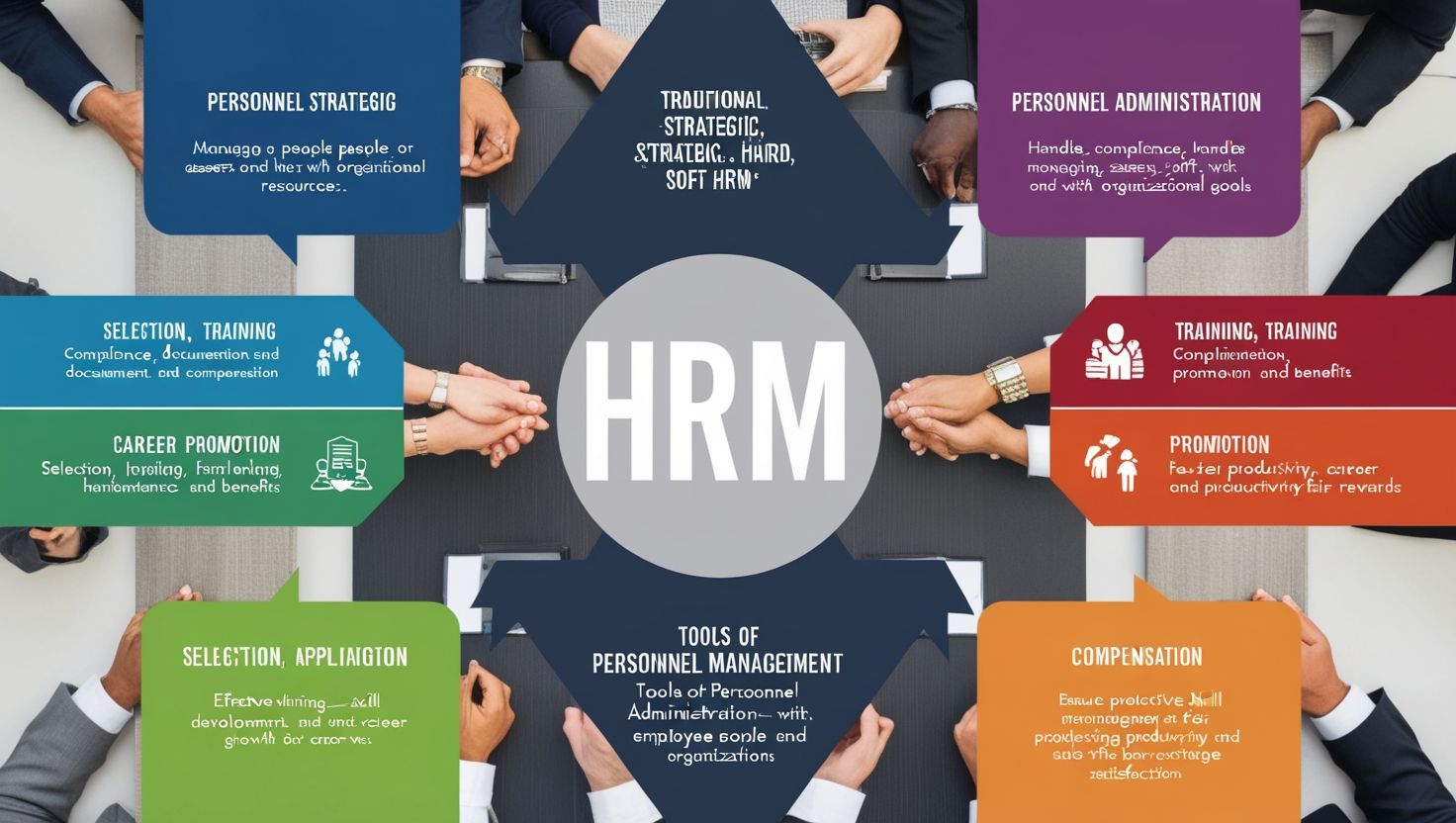Approaches to HRM and Tools of Personnel Administration, Human Resource Management (HRM) is pivotal to organizational success, encompassing strategic approaches to managing people effectively to drive business performance. The evolution of HRM has seen it transition from traditional personnel administration to a strategic partner in organizational growth. This article explores HRM approaches, personnel administration, and essential tools of personnel management, including selection, training, promotion, and compensation.
Approaches to Human Resource Management
1. Traditional Approach
The traditional approach to HRM views employees as expendable resources, emphasizing administrative functions. The focus lies on compliance, hierarchical structures, and ensuring policies and regulations are followed. Employee well-being and development are secondary considerations.
2. Strategic HRM Approach
Strategic HRM integrates human resources into the organization’s long-term goals. Employees are considered valuable assets, and the focus shifts to talent management, employee engagement, and aligning HR practices with business strategy. It involves proactive planning and fostering a culture of continuous improvement.
3. Hard HRM
Hard HRM emphasizes efficiency and cost-effectiveness. Employees are treated as resources whose performance must be maximized to achieve organizational objectives. This approach often focuses on workforce planning, cost control, and quantitative metrics.
4. Soft HRM
In contrast to hard HRM, soft HRM focuses on the human aspect of management, prioritizing employee satisfaction, motivation, and well-being. It encourages participative decision-making, learning opportunities, and supportive leadership.
5. Behavioral Approach
This approach emphasizes understanding employee behavior, attitudes, and motivation. By leveraging psychological theories and practices, organizations foster a work environment that enhances productivity and job satisfaction.
6. Systems Approach
The systems approach views HRM as an interconnected system where various subsystems—such as recruitment, training, and performance management—work cohesively. It emphasizes alignment between HR activities and organizational goals.
Personnel Administration: Evolution and Role
Personnel administration refers to the traditional aspect of managing employees, focusing on tasks like recruitment, record-keeping, and ensuring compliance with labor laws. While it is narrower than modern HRM, it remains fundamental to organizational operations.
Key Functions of Personnel Administration
- Compliance: Ensuring adherence to labor laws and organizational policies.
- Documentation: Maintaining accurate employee records.
- Conflict Resolution: Addressing workplace disputes.
- Benefits Administration: Overseeing compensation and benefits systems.
Personnel administration is often seen as the backbone of HRM, providing the structural support needed for strategic initiatives.

Tools of Personnel Management
1. Selection
Selection is the process of choosing the right candidate from a pool of applicants. It ensures that the organization hires individuals with the skills, qualifications, and cultural fit necessary for the role.
- Methods of Selection:
- Screening Resumes: Initial filtering of applications.
- Interviews: Assessing candidates’ skills, experience, and compatibility.
- Aptitude Tests: Evaluating specific competencies.
- Reference Checks: Verifying past performance and behavior.
An effective selection process reduces turnover, enhances productivity, and fosters a strong organizational culture.
2. Training
Training equips employees with the knowledge and skills required to perform their roles effectively. It is an investment in the workforce, enhancing organizational competitiveness.
- Types of Training:
- On-the-Job Training: Practical learning while performing tasks.
- Off-the-Job Training: Structured programs like workshops and seminars.
- Skill Development: Focused on technical or soft skills.
- Leadership Training: Preparing employees for managerial roles.
- Benefits of Training:
- Increased efficiency and innovation.
- Improved job satisfaction and morale.
- Enhanced adaptability to technological and market changes.
3. Promotion
Promotion recognizes employee performance and potential by advancing them to roles with greater responsibility and remuneration. It serves as both a motivational tool and a method of talent retention.
- Types of Promotion:
- Merit-Based: Based on performance metrics.
- Seniority-Based: Rewarding long-term service.
- Mixed Approach: Combining merit and seniority considerations.
- Benefits of Promotion:
- Encourages higher performance.
- Retains top talent by offering career growth.
- Reinforces organizational loyalty.
4. Compensation
Compensation refers to the monetary and non-monetary rewards provided to employees for their work. It is a crucial element in attracting and retaining talent.
- Components of Compensation:
- Base Salary: Fixed pay for job responsibilities.
- Bonuses and Incentives: Performance-based rewards.
- Benefits: Health insurance, retirement plans, and leave policies.
- Non-Monetary Rewards: Recognition programs, flexible work arrangements.
- Importance of a Fair Compensation System:
- Ensures equity and job satisfaction.
- Boosts employee morale and productivity.
- Enhances the organization’s reputation in the job market.
Integrating Tools with HRM Approaches
The success of HRM depends on aligning personnel management tools with chosen approaches. For instance:
- In a strategic HRM approach, training programs are designed to align with long-term business goals.
- Soft HRM emphasizes recognition and compensation systems that prioritize employee well-being.
- Systems approach integrates all tools seamlessly, ensuring that selection, training, promotion, and compensation are interdependent and contribute to organizational objectives.
Challenges in HRM and Personnel Management
Despite advancements, organizations face several challenges in implementing effective HRM and personnel administration:
- Technological Changes: Keeping pace with automation and digital tools.
- Workforce Diversity: Managing employees from varied backgrounds.
- Retention Issues: Addressing high turnover rates in competitive industries.
- Compliance: Adhering to complex labor laws and regulations.
Future Trends in HRM
HRM continues to evolve, with several emerging trends reshaping the field:
- Artificial Intelligence: Enhancing recruitment and training processes.
- Remote Work Management: Adapting tools to manage dispersed teams.
- Employee Analytics: Leveraging data for informed decision-making.
- Sustainability Practices: Incorporating eco-friendly and socially responsible policies.
Conclusion
Human Resource Management is more than an administrative function; it is a strategic enabler of organizational success. By adopting effective approaches and leveraging tools like selection, training, promotion, and compensation, organizations can create a workforce that is skilled, motivated, and aligned with business objectives. As HRM continues to adapt to global trends and challenges, its role in shaping the future of work remains indispensable.

10 thoughts on “Approaches to HRM and Tools of Personnel Administration”
Comments are closed.